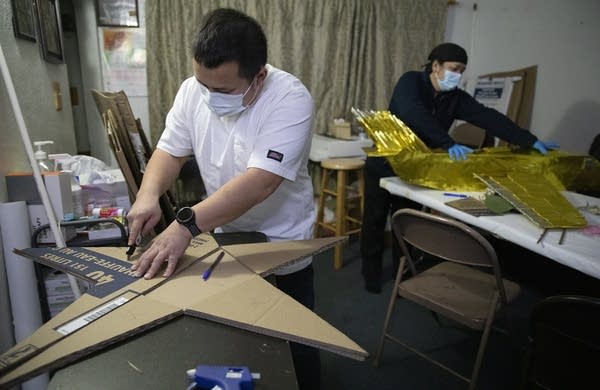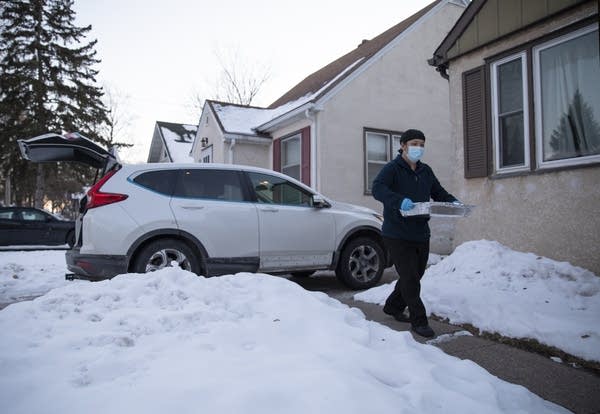Through grief, Hmong families torn between honoring the dead, keeping loved ones safe during COVID
Traditional Hmong funerals often carry on for days as loved ones send the deceased into the afterlife

Go Deeper.
Create an account or log in to save stories.
Like this?
Thanks for liking this story! We have added it to a list of your favorite stories.
Mai Vang suspects her father contracted COVID-19 from a funeral.
Vang and her family believe that traditional Hmong funerals are some of the most important rituals in their culture. Honoring the dead must be done with the utmost respect — and often involves loved ones gathering for days or even weeks to send the soul on its journey back to the ancestors.
But COVID-19 has made all of that challenging, and now Vang and her family have had to grapple with how to fulfill their obligations to their father — who died of the virus earlier this month — without turning his funeral this weekend into a coronavirus hot spot.
“My dad, he had tried so hard to stay alive,” she said. “He said he won’t go anywhere. He hardly [went] anywhere; he pretty much just stayed in one place.”
Turn Up Your Support
MPR News helps you turn down the noise and build shared understanding. Turn up your support for this public resource and keep trusted journalism accessible to all.
“And just that one event took my dad away.”

Vang’s father, Wang Ye Vang, got sick with the coronavirus in November. His family thinks he could’ve been exposed by another family member who was sick, or at a large funeral he attended. The 67-year-old was hospitalized until doctors could no longer help him, and his children chose to bring him back home, where he died surrounded by family.

In normal times, relatives and friends would gather for days or weeks, cooking side by side and consoling one another as part of the funeral proceedings. But with COVID-19 raging through their community, Vang and her 11 siblings have been thinking about how to plan a funeral that won’t be as big and lavish as they’d imagined.
Her husband, Chai Xiong, said the new protocols have shortchanged the practices that tradition requires.
“Before, we would do the ceremony, each step by step to make sure the person is spiritually got sent back to where they came from. And now it’s almost like, ‘Here is a plane ticket. Go,’” Xiong said.

Minnesota has allowed funerals to continue, with restrictions, and public health officials say large gatherings of any kind can be risky. But Hmong funerals in particular require anywhere from several hours to several weeks of congregating and mourning.
Kou Thao, who leads the Minnesota Department of Health’s Center for Health Equity, said not being able to continue funeral practices in the traditional sense has been triggering for community members.
“There have been so many instances in our history where fleeing Laos during the Vietnam War, or the Thai refugee camps, coming to America, where we did not have the opportunity to properly bury our dead and honor them and send them into the afterlife,” he said.
But he added that the community has adapted to other challenging times in the past and the pandemic has been another test of resilience. The challenges don’t have to mean an improper goodbye, he said.
“The message that we want to send to our community, we can continue to honor our practices and our rituals and have a proper burial and sending off for our loved ones,” Thao said. “It will look different.”
A look at the numbers
Minnesota is home one of the largest urban concentrations of Hmong people in the United States. And while research shows that Asian Americans in the United States are dying of COVID-19 at a lower rate than whites, Minnesota is among the states that have seen the highest age-adjusted mortality rates of Asian residents.
The Minnesota Department of Health does not collect specific ethnic data within Asian groups when contact tracing, so it’s unclear what role, if any, Hmong funerals have played in the spread of the virus. But families in the community fear it’s being transmitted at these events. According to data provided by the department, 263 COVID-19 cases have been linked to funerals of all faiths and communities since June.
Chong Lee, the Minnesota Department of Health’s Asian and Pacific Islander COVID-19 community liaison lead, has lost friends and relatives to the virus. She worked with Hmong spiritual leaders to develop guidance for best practices specific to traditional Hmong funerals.
“If they’re well-known community leaders, the family members are going to want to ensure that they invite all people to attend,” she said.
Although people are cautious about the state’s restrictions, Lee said things can still get out of hand when families choose to invite distant relatives and allow many people to attend and share several meals over the course of several days.
“When someone passes away, anyone who knows the individual wants to be there,” she said. “Funeral services that the Hmong community holds, it can be very complex, but it can be very simple, too.”

The state guidance for Hmong funerals say they can be conducted in just a few hours or one day — and can include essential elements like reed pipe songs and a blessing ceremony, in which only the guests of honor or distinguished leaders of the family can make remarks. The blessing ceremony is meant to right the wrongs so that the deceased no longer bears blame as they enter the afterlife.
After she lost her father, Mai Vang took to cooking as a therapeutic way to help her grieving brothers and sisters — and to avoid being in her own head about the devastating toll the virus has taken on her community.
Vang lost her hearing a few years ago, so sitting with family makes her grief even more intense because she can’t hear what others are saying. Instead, she’s been cooking at her restaurant, the Eggroll Queen in Falcon Heights, Minn. In recent days, she hasn’t been wrapping and rolling her popular eggrolls for customers, but boiling seafood dinners, frying Hmong sausages and stuffing chicken for her family.
As relatives make paper money and console one another, Vang is trying to help from afar, dropping off food to her father’s home, where some of the funeral preparations are taking place.
“When your person dies, you can’t do much anymore,” she said. “You spend time with the family, you’re just going to be more sad. So I just want to be useful to help the family, ease their pain.”
For her father’s funeral, the family is still planning a 14-hour affair with food. But Vang has decided to limit the number of people who can help her cook — and she’s only inviting close family members to the event.
Several family members have already contracted the virus and others are testing regularly, which eases some of their concerns about gathering. The family is also advising some of the funeral attendees to eat in their cars.
Vang is also imploring her guests to tell their elders to stay home.
“Because once they go, you will never see them again, it will be too late,” she said through tears. “Every day I look at my dad’s picture and I just know that it will never be the same.”
COVID-19 in Minnesota
Data in these graphs are based on the Minnesota Department of Health's cumulative totals released at 11 a.m. daily. You can find more detailed statistics on COVID-19 at the Health Department website.
The coronavirus is transmitted through respiratory droplets, coughs and sneezes, similar to the way the flu can spread.
Dear reader,
Political debates with family or friends can get heated. But what if there was a way to handle them better?
You can learn how to have civil political conversations with our new e-book!
Download our free e-book, Talking Sense: Have Hard Political Conversations, Better, and learn how to talk without the tension.






